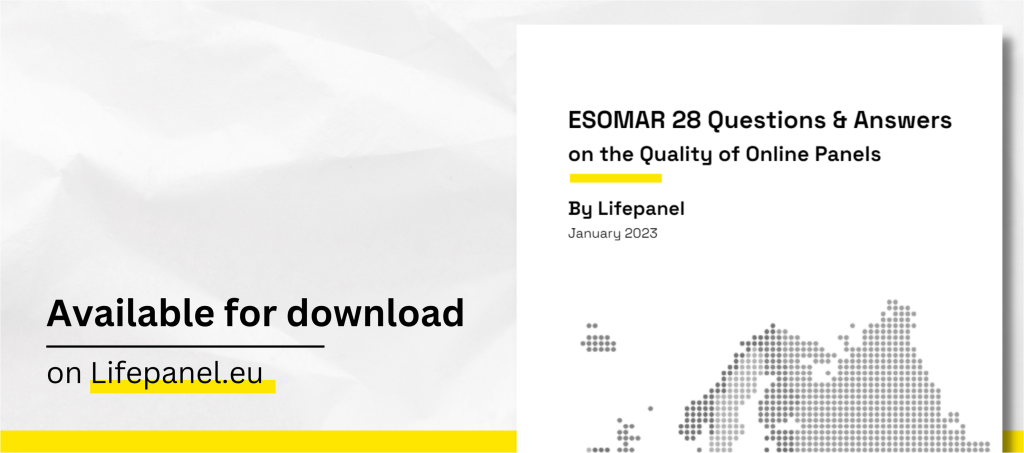Online probability panels have emerged as a popular method for gathering robust data, as the demand for accurate and reliable high-quality survey research has soared among the academic research community. However, ensuring the quality of collected data from online probability panels is crucial for obtaining meaningful and valid research outcomes and results for social research.
So what are the key quality indicators for online probability panels? We are shedding light on the crucial factors that should be considered when evaluating the reliability and representativeness of online probability panels.
1. Recruitment and Representative sample:
The first quality indicator is the panel recruitment process and the sampling methodology. The panel should employ probability-based sampling techniques, such as random digit dialing probability sample (RDD sample) or address-based sampling, which guarantee a fair chance of selection for every individual in the target population. This avoids the self-selection biases which are predominantly present in access (non-probability) panels. Each panel member should be randomly selected from the full-frame size of the general population.
The demographic information collected to assess the composition of the panel is therefore compared to the target population made available – to ensure representative data of the probability panel.
Lifepanel uses the advantages of a full probability telephone sample (simple random sample) to invite potential respondents to join the panel where each individual of the population has an equal probability to be selected. They are recruited via SMS, CATI, or WhatsApp.
2. Panel members‘ Profiling and Data Validation
Thorough panelist profiling and validation are essential for quality panel data. Profiling consists of collecting demographic and socio-economic data from respondents during the recruitment process but also each panel member should be often invited to edit or update their profile.
This helps to ensure that the panel remains representative of the target population over time. Inaccurate or outdated information can compromise the validity of research findings and lead to incorrect conclusions. Therefore, continuous efforts should be made to maintain accurate and up-to-date profiles, which can ultimately enhance the reliability and validity of panel data.
Having an external verification in place can detect and address inaccurate data provided by panel members when validating their profiles. Lifepanel uses double opt-in with two-factor authentication and phone verification during the registration process. Once confirmed via SMS or email, members can update their social demographics.
3. Transparency and Documentation
Probability-based panels must be transparent and should document their recruitment, maintenance, and data collection process, including panel recruitment sources, sampling frames, panelist incentives, response rates, and weighting procedures to address biases. This enhances the credibility and trustworthiness of the panel data.
If this is something you would like to dive into in more detail, we invite you to check Lifepanel’s ESOMAR 28 Questions & Answers on the Quality of Online Panels.

4. Data Quality Checks
To ensure accurate and reliable data, quality control measures like data cleaning and validation are used to identify issues such as duplicate responses, straight-lining, or speeding through surveys. The quality of data can be enhanced through the application of data validation methods such as consistency checks, detecting occurrences of duplicate or fraudulent responses, employing attention checks and validation questions, and employing quality assurance protocols to detect data that is inconsistent or may be unreliable.
5. Effective use of incentives
Incentives serve as powerful motivators for respondents to participate in surveys and provide accurate responses. By offering appealing incentives, such as monetary rewards, gift cards, or entry into prize draws, people are more likely to be engaged and committed to completing surveys promptly. By fostering a positive relationship with panelists, researchers can improve response rates and reduce attrition, ultimately leading to higher-quality data.
Consideration should be given to the timing and delivery of incentives to maximize their effectiveness. Offering incentives promptly after survey completion can reinforce positive behavior and incentivize future participation. Moreover, providing a variety of redemption options and convenient delivery methods (e.g., electronic vouchers) can enhance the appeal and accessibility of incentives, resulting in increased panelist satisfaction and engagement.
Finally, to enhance the quality of responses, it is essential to align incentives with the effort required from panelists. Longer or more complex surveys may warrant higher incentives to compensate for the additional time and cognitive effort required.
Incentives are often used to encourage people to complete surveys, but they can have a negative impact on the quality of responses. While incentives may seem like a good idea, they can actually lead to biased and unreliable data.
6. Coverage of the target population
There are limitations to their coverage, which can impact the accuracy and representativeness of the data collected.
One of the main limitations of online probability panels is that they rely on respondents having access to the internet. While Internet access has become more widespread in recent years, there are still many people who do not have access to the Internet or who have limited access.
In order to get coverage on the offline population as well, it makes sense to make use of mixed-mode panels rather than pure online-probability panels.
Another limitation is that online probability panels may not be able to reach certain segments of the population, such as those who are elderly or living in rural areas. These groups may be less likely to have (mobile or computer) internet access or may be less familiar with how to use online surveys, which can lead to underrepresentation in the sample.
7. Completion rate and panelists’ engagement in online surveys
High completion rates and engagement of panel members enhance research quality and effectiveness. By definition, completion rate is the percentage of members who complete the study, while engagement measures their active involvement, interest, and responsiveness.
To ensure a high completion rate, the survey design must be clear, concise, and engaging. Long and tedious questionnaires can discourage participants. Incentives like monetary rewards or gift cards can motivate participants to stay committed. Engaged participants provide accurate responses, leading to higher data quality. Lifepanel boosts engagement through regular communication, timely updates, acknowledgment, and fostering a sense of community.
Finally, utilizing user-friendly platforms and infrastructure can enhance the overall panel member experience, and increase engagement and positive attitude. Employing mobile-friendly designs, interactive elements, and multimedia content can make the panel more visually appealing and engaging for participants.
In conclusion, online probability panels provide a valuable means of collecting survey data, but it is important to ensure their quality. By taking into account the key indicators outlined in this blog post, researchers and survey practitioners can make informed decisions about whether online probability panels are suitable for their research goals. As technology advances and new challenges arise, ongoing evaluation and enhancement of quality indicators will be critical to preserving the credibility and dependability of online probability panels. This will allow researchers to draw precise conclusions and make well-informed decisions based on evidence.


